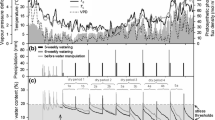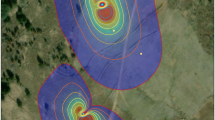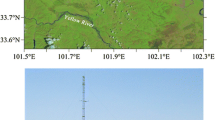Abstract
Eddy covariance was used to measure above-canopy exchanges of CO2 and water vapor at an operational plantation of hybrid poplar (variety “Walker”) established on marginal agricultural land in east central Alberta, Canada. Winter ecosystem respiration (R e) rates were inferred from seasonal changes in the normalized respiration rate at 10°C (R 10) for the growing season and observations of soil CO2 concentration measured with solid-state probes. Over five consecutive growing seasons following planting, gross ecosystem production (GEP) increased each year, ranging from 21 g C m−2 y−1 in year 1 to 469 g C m−2 y−1 in year 5. During this period, the annual carbon balance shifted from a net source of greater than 330 g C m−2 in year 1 to approximately C-neutral in year 5. Total carbon (C) release over 5 years likely exceeded 630 g C m−2. Intra- and interannual variations in temperature and soil water availability greatly affected annual C balance each year. GEP and R e were particularly sensitive to temperature during spring and to soil water availability in summer: year 5 was notable because a cold spring and accumulating drought caused growth and carbon uptake to fall well below their potential. Annual evapotranspiration (ET) increased slightly with leaf area, from 281 mm in year 1 to 323 mm in year 4, but in year 5 it declined, while exceeding total precipitation (P). This trend of increasing annual ET/P suggests that annual GEP could become increasingly water-limited in years with below normal precipitation, as the plantation achieves maximum leaf area. Measured canopy albedos did not change appreciably over three winters, suggesting that estimates of increased radiative forcing resulting from afforestation in high latitudes could be exaggerated in regions where fast-growing deciduous plantations are managed on short (~20-year) rotations.








Similar content being viewed by others
References
Amiro BD. 2001. Paired-tower measurements of carbon and energy fluxes following disturbance in the boreal forest. Glob Change Biol 7(3):253–68.
Arevalo CBM, Bhatti JS, Chang SX, Sidders D. 2009. Ecosystem carbon stocks and distribution under different land-uses in north central Alberta, Canada. For Ecol Manag 257:1776–85.
Bala G, Caldeira K, Wickett M, Phillips TJ, Lobell DB, Delire C, Mirin A. 2007. Combined climate and carbon-cycle effects of large-scale deforestation. Proc Natl Acad Sci 104(16):6550–5.
Barr AG, Black TA, Hogg EH, Griffis TJ, Morgenstern K, Kljun N, Theede A, Nesic Z. 2007. Climatic controls on the carbon and water balances of a boreal aspen forest, 1994–2003. Glob Change Biol 13(3):561–76.
Betts AK, Ball JH. 1997. Albedo over the boreal forest. J Geophys Res 102(D24):28901–9.
Betts RA. 2000. Offset of the potential carbon sink from boreal forestation by decreases in surface albedo. Nature 408(6809):187–90.
Black TA, Chen WJ, Barr AG, Arain MA, Chen Z, Nesic Z, Hogg EH, Neumann HH, Yang PC. 2000. Increased carbon sequestration by a boreal deciduous forest in years with a warm spring. Geophys Res Lett 27(9):1271–4.
Bonan GB. 2008. Forests and climate change: forcings, feedbacks, and the climate benefits of forests. Science 320(5882):1444–9.
Bonan GB, Pollard D, Thompson SL. 1992. Effects of boreal forest vegetation on global climate. Nature 359(6397):716–18.
Bond-Lamberty B, Wang C, Gower ST. 2004. A global relationship between the heterotrophic and autotrophic components of soil respiration? Glob Change Biol 10:1756–66.
Burba GG, Anderson DJ, Xu L, McDermitt DK. 2006. Correcting apparent off-season CO2 uptake due to surface heating of an open-path gas analyzer: progress report of an ongoing experiment. In: Proceedings of 27th annual conference of agricultural and forest meteorology, San Diego, California.
Cai T, Flanagan LB, Syed KH. 2010. Warmer and drier conditions stimulate respiration more than photosynthesis in a boreal peatland ecosystem: analysis of automatic chambers and eddy covariance measurements. Plant Cell Environ 33(3):394–407.
Chase TN, Pielke RA, Kittel TGF, Nemani R, Running SW. 1996. Sensitivity of a general circulation model to global changes in leaf area index. J Geophys Res 101(D3):7393–408.
Clark KL, Gholz HL, Castro MS. 2004. Carbon dynamics along a chronosequence of slash pine plantations in north Florida. Ecol Appl 14(4):1154–71.
Coursolle C, Margolis HA, Barr AG, Black TA, Amiro BD, McCaughey JH, Flanagan LB, Lafleur PM, Roulet NT, Bourque CPA et al. 2006. Late-summer carbon fluxes from Canadian forests and peatlands along an eastwest continental transect. Can J For Res 36:783–800.
Davidson EA, Janssens IA. 2006. Temperature sensitivity of soil carbon decomposition and feedbacks to climate change. Nature 440(7081):165–73.
Falge E, Tenhunen J, Baldocchi D, Aubinet M, Bakwin P, Berbigier P, Bernhofer C, Bonnefond J, Burba G, Clement R et al. 2002. Phase and amplitude of ecosystem carbon release and uptake potentials as derived from FLUXNET measurements. Agric For Meteorol 113(1–4):75–95.
Goulden Ml, Winston GC, Mcmillan AMS, Litvak ME, Read El, Rocha AV, Elliot JR. 2006. An eddy covariance mesonet to measure the effect of forest age on land–atmosphere exchange. Glob Change Biol 12(11):2146–62.
Griffis TJ, Black TA, Morgenstern K, Barr AG, Nesic Z, Drewitt GB, Gaumont-Guay D, McCaughey JH. 2003. Ecophysiological controls on the carbon balances of three southern boreal forests. Agric For Meteorol 117(1–2):53–71.
Hanson PJ, Edwards NT, Garten CT, Andrews JA. 2000. Separating root and soil microbial contributions to soil respiration: a review of methods and observations. Biogeochemistry 48:115–46.
Högberg P, Nordgren A, Buchmann N, Taylor AFS, Ekblad A, Högberg MN, Nyberg G, Ottosson-Löfvenius M, Read DJ. 2001. Large-scale forest girdling shows that current photosynthesis drives soil respiration. Nature 411(6839):789–92.
Hogg EH. 1994. Climate and the southern limit of the western Canadian boreal forest. Can J For Res 24:1835–45.
Hogg EH, Brandt JP, Kochtubajda B. 2005. Factors affecting interannual variation in growth of western Canadian aspen forests during 1951–2000. Can J For Res 35:610–22.
Hogg EH, Price DT, Black TA. 2000. Postulated feedbacks of deciduous forest phenology on seasonal climate patterns in the western Canadian interior. J Clim 13(24):4229–43.
Humphreys ER, Black TA, Morgenstern K, Cai T, Drewitt GB, Nesic Z, Trofymow JA. 2006. Carbon dioxide fluxes in coastal Douglas-fir stands at different stages of development after clearcut harvesting. Agric For Meteorol 140(1–4):6–22.
IPCC. 2007. Climate change 2007: the physical science basis. Contribution of Working Group I to the Fourth Assessment. In: Solomon S, Qin D, Manning M, Chen Z, Marquis M, Averyt KB, Tignor M, Miller HL, Eds. Report of the Intergovernmental Panel on Climate Change. Cambridge: Cambridge University Press, 996 pp.
Jackson RB, Jobbagy EG, Avissar R, Roy SB, Barrett DJ, Cook CW, Farley KA, le Maitre DC, McCarl BA, Murray BC. 2005. Trading water for carbon with biological carbon sequestration. Science 310(5756):1944–7.
Jassal RS, Black TA, Cai T, Ethier G, Pepin S, Brümmer C, Nesic Z, Spittlehouse DL, Trofymow JA. 2010. Impact of nitrogen fertilization on carbon and water balances in a chronosequence of three Douglas-fir stands in the Pacific Northwest. Agric For Meteorol 150(2):208–18.
Jassal R, Black A, Novak M, Morgenstern K, Nesic Z, Gaumont-Guay D. 2005. Relationship between soil CO2 concentrations and forest-floor CO2 effluxes. Agric For Meteorol 130(3–4):176–92.
Johnsen K, Maier C, Sanchez F, Anderson P, Butnor J, Waring R, Linder S. 2007. Physiological girdling of pine trees via phloem chilling: proof of concept. Plant Cell Environ 30(1):128–34.
Kljun N, Black T, Griffis T, Barr A, Gaumont-Guay D, Morgenstern K, McCaughey J, Nesic Z. 2006. Response of net ecosystem productivity of three boreal forest stands to drought. Ecosystems 9(7):1128–44.
Krishnan P, Black TA, Grant NJ, Barr AG, Hogg EH, Jassal RS, Morgenstern K. 2006. Impact of changing soil moisture distribution on net ecosystem productivity of a boreal aspen forest during and following drought. Agric For Meteorol 139(3–4):208–23.
Litvak M, Miller S, Wofsy SC, Goulden M. 2003. Effect of stand age on whole ecosystem CO2 exchange in the Canadian boreal forest. J Geophys Res 108(D3):8225.
McMaster GS, Wilhelm WW. 1997. Growing degree-days: one equation, two interpretations. Agric For Meteorol 87(4):291–300.
Menzel A, Sparks TH, Estrella N, Koch E, Aasa A, Ahas R, Alm-Kübler K, Bissolli P, Braslavská O, Briede A et al. 2006. European phenological response to climate change matches the warming pattern. Glob Change Biol 12(10):1969–76.
Monson RK, Lipson DL, Burns SP, Turnipseed AA, Delany AC, Williams MW, Schmidt SK. 2006. Winter forest soil respiration controlled by climate and microbial community composition. Nature 439(7077):711–14.
Montenegro A, Eby M, Qiaozhen M, Mulligan M, Weaver AJ, Wiebe EC, Zhao M. 2009. The net carbon drawdown of small scale afforestation from satellite observations. Glob Planet Change 69(4):195–204.
Myneni RB, Keeling CD, Tucker CJ, Asrar G, Nemani RR. 1997. Increased plant growth in the northern high latitudes from 1981 to 1991. Nature 386(6626):698–702.
Natural Resources Canada. 2004. Forest carbon accounting: definitions. http://carbon.cfs.nrcan.gc.ca/definitions_e.html.
Natural Resources Canada. 2006. Feasibility assessment of afforestation for carbon sequestration (FAACS) initiative. Final report. Ottawa: Canadian Forest Service, 41 pp. http://cfs.nrcan.gc.ca/subsite/afforestation/feasibilityafforestation.
Peichl M, Arain MA, Brodeur JJ. 2010. Age effects on carbon fluxes in temperate pine forests. Agric For Meteorol 150:1090–101. doi:10.1016/j.agrformet.2010.04.008.
Piao S, Ciais P, Friedlingstein P, Peylin P, Reichstein M, Luyssaert S, Margolis H, Fang J, Barr A, Chen A et al. 2008. Net carbon dioxide losses of northern ecosystems in response to autumn warming. Nature 451(7174):49–52.
Pielke Sr RA. 2001. Influence of the spatial distribution of vegetation and soils on the prediction of cumulus convective rainfall. Rev Geophys 39(2):151–78.
Reichstein M, Falge E, Baldocchi D, Paple D, Aubinet M, Berbigier P, Bernhofer C, Buchmann N, Gilmanov T, Granier A, Grünwald T et al. 2005. On the separation of net ecosystem exchange into assimilation and ecosystem respiration: review and improved algorithm. Glob Change Biol 11(9):1424–39. doi:10.1111/j.1365-2486.2005.001002.x.
Saurette DD, Chang SX, Thomas BR. 2006. Some characteristics of soil respiration in hybrid poplar plantations in northern Alberta. Can J Soil Sci 86:257–68.
Saurette DD, Chang SX, Thomas BR. 2008. Land-use conversion effects on CO2 emissions: from agricultural to hybrid poplar plantation. Ecol Res 23:623–33.
Schmidt S, Wilson K, Monson R, Lipson D. 2009. Exponential growth of “snow molds” at sub-zero temperatures: an explanation for high beneath-snow respiration rates and Q 10 values. Biogeochemistry 95(1):13–21.
Schneider RR. 2002. Alternative Futures, Alberta’s Boreal Forest at the Crossroads. Edmonton (AB): Federation of Alberta Naturalists and Alberta Centre for Boreal Research, 152 pp. http://www.borealcentre.ca/reports/reports.html.
Schneider R, Dyer S. 2006. Death by a thousand cuts: impacts of in situ oil sands development on Alberta’s boreal forest. Edmonton (AB), Drayton Valley (AB): Canadian Parks and Wilderness Society and The Pembina Institute, 36 pp. pubs.pembina.org/reports/1000-cuts.pdf.
Schulze E, Lloyd J, Kelliher FM, Wirth C, Rebmann C, Lühker B, Mund M, Knohl A, Milyukova IM, Schulze W et al. 1999. Productivity of forests in the Eurosiberian boreal region and their potential to act as a carbon sink—a synthesis. Glob Change Biol 5(6):703–22.
Sellers PJ, Hall FG, Kelly RD, Black A, Baldocchi D, Berry J, Ryan M, Ranson KJ, Crill PM, Lettenmaier DP et al. 1997. BOREAS in 1997: experiment overview, scientific results, and future directions. J Geophys Res 102(D24):28731–69.
Sperry J. 2003. Evolution of water transport and xylem structure. Int J Plant Sci 164:S115–27.
Van Dijk AIJM, Dolman AJ. 2004. Estimates of CO2 uptake and release among European forests based on eddy covariance data. Glob Change Biol 10(9):1445–59.
Webb EK, Pearman GI, Leuning R. 1980. Correction of flux measurements for density effects due to heat and water vapour transfer. Q J R Meteorol Soc 106:85–100.
Wilson K, Goldstein A, Falge E, Aubinet M, Baldocchi D, Berbigier P, Bernhofer C, Ceulemans R, Dolman H, Field C et al. 2002. Energy balance closure at FLUXNET sites. Agric For Meteorol 113(1–4):223–43.
Acknowledgements
We would like to thank management and staff of Alberta-Pacific Forest Industries Inc. for their continued interest and financial support. Derek Sidders, Jag Bhatti, Carmela Arevalo and Marty Siltanen of Natural Resources Canada, Northern Forestry Centre in Edmonton, have provided much input throughout the course of the study. Scott Chang and Robert Grant of the University of Alberta, and Rachhpal (Paul) Jassal and Andy Black of UBC have all contributed help and ideas. Don Huber, owner of the Huber Farm near Ashmont, Alberta, has allowed us unhindered access to the site. We greatly appreciate the valuable comments and suggestions from Altaf Arain of McMaster University who reviewed an early version of the manuscript, as well as the positive and helpful suggestions from two anonymous reviewers.
Author information
Authors and Affiliations
Corresponding author
Additional information
Author Contributions
TC performed the data analysis presented in this article and drafted the methodology and results. DTP conceived the study, located the site and contributed significantly to writing the article. ALO turned the concept into reality, set up and maintained the eddy covariance system and other instrumentation, and organized data sets. BRT assisted greatly with site selection, provided expertise on hybrid poplar plantation establishment, coordinated management operations at the study site and contributed to the writing.
Rights and permissions
About this article
Cite this article
Cai, T., Price, D.T., Orchansky, A.L. et al. Carbon, Water, and Energy Exchanges of a Hybrid Poplar Plantation During the First Five Years Following Planting. Ecosystems 14, 658–671 (2011). https://doi.org/10.1007/s10021-011-9436-8
Received:
Accepted:
Published:
Issue Date:
DOI: https://doi.org/10.1007/s10021-011-9436-8




